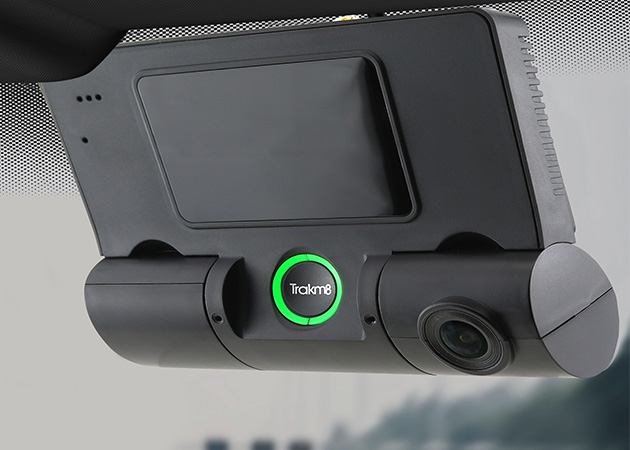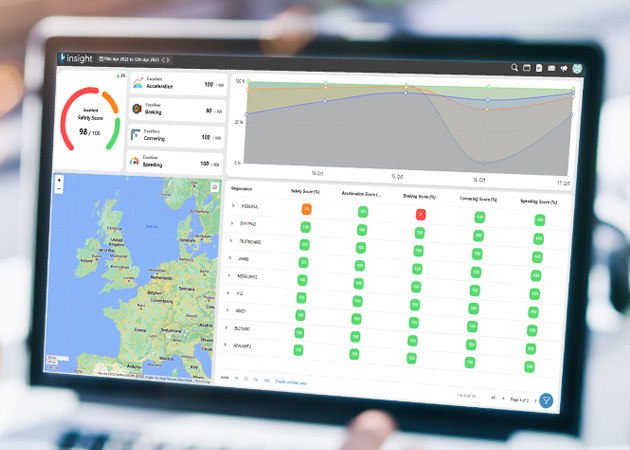Safety is critical for any business that operates a fleet of vehicles. Compliance with fleet safety regulations is essential of course, but crucially it’s also about protecting your employees, your fleet assets, and your company reputation.
Fleet safety management focuses on reducing risks on the road and vehicle collisions. Increasingly it utilises AI-powered camera technology, fleet safety analytics and real-time telematics data to identify potential areas of concern and mitigate them before safety incidents occur.
Whether you’re a fleet manager, safety officer, or a business owner, this guide will offer valuable insights to help you enhance the safety of your fleet operations.
Table of contents:
- What is fleet safety?
- Driver safety and training
- Vehicle maintenance and safety checks
- Fleet safety cameras and monitoring
- Telematics and analytics
- Fleet safety certifications
- Safety audits and compliance
What is fleet safety?
Fleet safety refers to the safety policies and practices implemented to prevent accidents involving fleet vehicles and drivers, and to ensure fleet operations comply with UK safety regulations. It is a key aspect of fleet management and broader health and safety.
Safety practices for fleets typically include ensuring that vehicles are in good condition and well maintained, training drivers to operate vehicles safely and responsibly, and using technology to monitor driver behaviour and pro-actively identify risks.
Key to deploying these is creating and enforcing a clear fleet safety policy. An effective fleet safety policy creates a safe environment for both fleet drivers and other road users, providing clear guidance for drivers and helping to ensure consistent safety practices.
Safety in fleet operations
A pro-active approach to fleet safety is crucial for several reasons. Firstly, and most importantly, it helps to protect the lives of drivers and other road users.
Secondly, it helps reduce number of crashes and save companies significant costs associated with those accidents. These can include vehicle repair costs, insurance claims and premiums, and potential legal fees.
Moreover, a strong commitment to fleet safety can enhance a company’s reputation, showing that the company values safety and is committed to responsible business practices.
Core components of fleet safety
Fleet safety management involves several key components. These include fleet safety certification, the use of fleet safety cameras, and the creation of a fleet safety policy.
Each of these components plays a crucial role in promoting safety. They help to ensure that companies meet regulatory requirements and best practices.
Driver safety and training
Driver training and education are a crucial pillar of fleet safety. They can help drivers understand safety procedures, common risks and expectations.
Training should typically cover a range of topics, including safe driving practices, accident response procedures, and regulatory compliance.
Regular refresher courses can help to reinforce drivers’ safety knowledge, ensuring that they stay up to date with the latest safety practices. In-cab driver behaviour monitoring and feedback devices (such as the Trakm8 ACC750) can also provide driver coaching in real time, delivering visual alerts and audio notifications when sub-optimal driving is detected.
Vehicle maintenance and safety checks
Regular inspections and maintenance are key to ensuring your fleet vehicles are safe to drive. This can help to prevent breakdowns and accidents caused by vehicle faults, and is vital in complying with the Road Vehicles (Construction and Use) Regulations 1996.
Daily fleet vehicle safety checks are also mandatory to comply with Vehicle and Operator Services Agency (VOSA) requirements.
Safety checks should cover key areas such as brakes, tyre pressure and condition, lights, oil/fluids, and mirrors. A full checklist of daily safety checks can be found on the VOSA website.
When issues are identified during safety inspections, appropriate maintenance should be scheduled. Maintenance records should be kept for each vehicle to help ensure that all vehicles are maintained to a high standard.
Some fleet telematics platforms, such as Trakm8 Insight, can monitor vehicle health data remotely – sending real-time alerts to fleet managers if dashboard warning lights are triggered or Diagnostic Trouble Codes are detected.
Fleet safety cameras: Monitoring for compliance and security
Fleet safety cameras are a valuable tool for monitoring driver behaviour. They can help to identify unsafe driving practices and provide opportunities for coaching drivers to improve, and prevent accidents.
Footage from vehicle cameras can also provide evidence in the event of an incident, which can be crucial for insurance claims or legal proceedings.
Front-facing safety cameras can help identify risky driver behaviours such as poor lane discipline, whilst internal driver-facing cameras can pick up in-cab issues like incidences of distracted driving.

Telematics and Analytics
Telematics systems can play a crucial role in enhancing fleet safety management by providing real-time data on vehicle performance and driver behaviour.
For example, behaviours such as harsh braking, acceleration, and cornering, can be detected and reported on using driver safety scores.
This data can be used to identify potential safety issues and provide insights for improving safety practices and driver behaviour. In-cab driver feedback devices can give in-the-moment nudges to drivers when these sub-optimal behaviours occur, coaching them over time.

The use of technology can also support other safety measures. For example, it can facilitate communication of safety policies and provide tools for driver training.
Fleet safety certifications
Accredited fleet safety schemes recognise that a company meets certain safety standards and signify that the company has implemented effective safety measures.
These accreditations can provide several benefits – including help to reduce insurance premiums, improve company reputation, and ensure compliance with regulations.
In the UK, fleet safety standards include:
FORS (Fleet Operator Recognition Scheme)
Safety standards are a key part of the Fleet Operator Recognition Scheme (FORS), a voluntary national scheme in the UK. FORS provides a range of safety training courses designed to help drivers adopt safe driving practices on the road and significantly reduce the chances of having a road accident. It also provides safety accreditation for fleets as part of its wider certification.
Direct Vision Standard (DVS) and HGV Safety Permit Scheme
The Direct Vision Standard (DVS) is a safety scheme focused on heavy goods vehicle (HGV) fleets operating in Greater London. Under the DVS, HGVs are given a rating based on the driver’s level of direct visibility around the vehicle. Vehicles with lower visibility ratings are required to take additional measures (such as installing additional vehicle cameras) in line with the Progressive Safe System (PSS) in order to gain a HGV Safety Permit. All HGVs with a load of more than 12 tonnes are required to have a HGV Safety Permit in order to operate in Greater London.
CLOCS Standard
CLOCS is a nationally recognised safety standard focused around reducing risk and improving the safety of fleet operators working in the construction sector and delivering goods to construction sites.
Crafting a Fleet Safety Policy
A fleet safety policy is a document that outlines a company’s safety procedures and expectations. It’s a critical component of fleet safety management.
This policy should cover several key areas:
- Driver training and education
- Vehicle maintenance procedures
- Use of safety technology
- Accident reporting and response procedures
- Compliance with regulations
A well-crafted policy can provide clear guidance for drivers and help to ensure consistent safety practices are implemented.
Building a Culture of Safety
Building a culture of safety is a key aspect of fleet safety management. This involves creating an environment where safety is a top priority for everyone, from drivers to managers.
A strong safety culture can help to reduce accidents and improve compliance with safety regulations. Promoting a safety culture requires clear communication of safety policies and expectations to all staff.
Incentives and Rewards for Safe Driving
Incentives, league tables and rewards can all be effective strategies in promoting safe driving, motivating drivers to adhere to safety policies.
For example, Trakm8’s Insight platform can use driving data to provide driver safety league tables, enabling fleet operators to reward the best drivers each month with prizes and incentivise safer driving behaviour. During the month, drivers can see a real-time display of their safety score and live coaching to help improve it through the ACC750 in-cab driver feedback device.
Rewards can take various forms, from simple driver recognition to bonuses or additional benefits. Incentives should be linked to measurable safety outcomes – such as a safety score on a telematics device or reduced frequency of safety incidents.
Data Analysis and Risk Assessment
Data analysis and risk assessment are key tools that can help to identify fleet safety risks. Fleet managers are required to carry out routine risk assessments of their fleet vehicles and operations to demonstrate compliance with the Management of Health and Safety at Work Regulations 1999.
Safety data can be collected from various sources – including accident reports, vehicle telematics, vehicle safety cameras and driver feedback.
Risk assessment involves analysing this data to identify risks, near misses, unsafe driving behaviours and trends in safety incidents. Based on this analysis, interventions can be developed, which can help to mitigate identified risks and improve safety.
Regular Safety Audits and Compliance
Regular safety audits are crucial for maintaining fleet safety. They involve checking compliance with safety policies and regulations.
Audits can help to identify areas of non-compliance to enable corrective actions to be taken. Compliance is not just about avoiding penalties. It also plays a key role in ensuring safety.
Regular audits can help to ensure that safety measures are effective, decreasing risk to drivers and providing reassurance to stakeholders about the organisation’s commitment to safety.
Conclusion
Fleet safety management is a comprehensive and ongoing process. By understanding and implementing these key principles, organisations can enhance their fleet safety to reduce accidents, improve efficiency, and build a stronger reputation.


